
CINET in Taiwan has recently completed the installation and commissioning of a point to point microwave link to transport the analog and digital cable TV signals between two islands.
The microwave system consists of a broadband outdoor transmitter operating in the 12.7 to 13.25 GHz band, and an out¬door broadband receiver.
At the transmitter site, the cable signal is fed directly to the transmitter in the frequency range of 54 to 600 MHz.
At the receiver site, the microwave receiver connects directly to the local cable network without the need for frequency converters or any other equipment.
The microwave system provides Cable TV service to the cable subscriber in the Is¬lands without the need to install a new headend.
Miranda Chen, CINET Vice President, says “we are very pleased with the quality of the signal and the level of support from Cable AML during installation and commissioning of the system.”
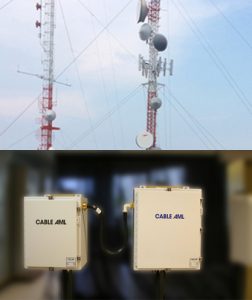
Mount Baker Cable, a Cable TV company in the state of Washington, has recently completed the upgrade of the microwave system transporting the cable TV signals from the Headend in Ferndale to Orcas Island (16 miles) and Lummi Island (7 miles), in Washington, USA.
The microwave system consists of a broadband outdoor transmitter operating in the 12.7 to 13.2 GHz band, feeding two paths simultaneously. At each of the receiver sites, the local receiver feeds the local cable network directly.
The microwave system allows Mount Baker Cable to continue to offer upgraded Cable TV service to the two Island communities.
Dan Adams, General Manager of the Cable system, mention “I am very pleased with the quality of the signal and the level of support from Cable AML during installation and turn-on of the system.”

When cable operator Sistema de Comunicaciones de Quiroga (Mexico) needed to feed 65 channels to two nearby towns in the Mexican state of Michoacan, the company chose Cable AML links to carry the signal 11 km and 25 km in different directions (San Andres and Eronguaricaro) from an existing headend at Quiroga.At the time, General Manager Alejandro Baltazar said, “we are extremely pleased with the performance of the Cable AML system.” Less than a year later Sistema decided to start delivering service to San Jose, a town about 22 km away.
The same transmitter originally installed to service San Andres and Eronguaricaro provided the signal required to the new town of San Jose through a Repeater, allowing the company to start cable service in San Jose from the Quiroga headend without the expense of a new headend. Ing. Alejandro Baltazar said, “The capability to expand the microwave system is creating opportunities for our company to provide Cable TV service to nearby towns in a very cost effective way, without the expense of a long fiber run or a new headend.”
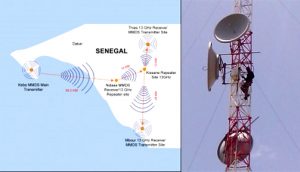
Residents of two towns in Senegal, Thies and Mbour, can now view 80 channels of digital Television thanks to the commissioning of new MMDS repeaters systems fabricated by Cable AML.
The digital TV signals originate in the existing digital MMDS system in the country’s capital, Dakar. A microwave link using broadband microwave radios from Cable AML is used to transport the digital signal 14 Kms to a repeater point at Kissane. From Kissane it is relayed to two new MMDS sites, one at Thies 10 Kms away and the other at Mbour, 28 Kms away. A broadband MMDS transmitter then re-transmits the signal for local subscribers at the two cities.
The installation and commissioning of the system has been under the technical direction of David Vine, who has previous experience with both DTT, MMDS and digital cable systems.
Mr. Vine said,“Duplicating the Dakar headend in Thies and Mbour would have been cost-prohibitive, With Cable AML’s equipment, we are able to provide excellent signal quality to residents in these two remote communities.”
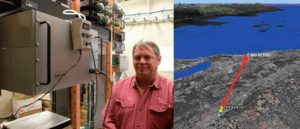
Connecting the headend to a building in the city center posed a challenge for CGI in Homer, Alaska. Cable AML came to the rescue with a Wireless HFC Extension. The 4 Kilometer bidirectional link carries the full Downstream and Upstream cable channel load on a single pair of antennas with radomes. The active electronics are all rack-mounted indoors.
The Headend was built on a ridge near the city. The very low look angle to geostationary satellites serving CONUS, requires satellite receive antennas in Alaska to be constructed on rises or on manmade structures.
The link interconnects the Headend with the central data site in the city center. Right-of-way issues and the high cost of constructing a fiber link made a microwave link the only feasible solution.

Cable AML has recently delivered and installed a transmitter and receiver upgrade to an existing 18 GHz link to transport digital video carriers within the campus of Santa Clara University (in California, USA).
Santa Clara University operates a large a state-of-the-art video and data network to provide connectivity services throughout campus. The microwave link provides video services to an area within the campus that can not be reached easily with fiber.According to Terry Benton, Manager of Linc-TV Services at Santa Clara University (California, USA), “we are very pleased with Cable AML’s fast response to our requests and the professional installation services provided for this upgrade.”
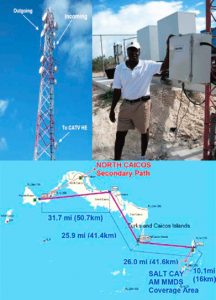
Residents on the islands of Grand Turk, Salt Cay, Providenciales , North Caicos, Middle Caicos, South Caicos and East Caicos experienced an immediate and dramatic improvement in the quality of communications from government facilities after installation of a digital microwave backbone designed and manufactured by Cable AML. The system architecture consists of a number of links in series as opposed to a “star” or Point-To-Multi Point approach in which all delivery originates from a single, common point. The three principal links in series are between 40km and 50km each, with a total route distance in excess of 130km, mostly over water. The combination of 5 links in series and spectrum constraints made it necessary to use digital MPEG2 encoding of the video channels and QAM modulation of the ASI carriers.
Fourteen receiving points downconvert the backbone signal to the conventional 54 to 870 MHz spectrum and feed rack-mounted Demodulators. The Demodulators feed signal to existing CATV systems that had never previously been interconnected.
A Cable AML MMDS transmitter in Salt Cay delivers analog signals from Grand Turk directly to subscribers.
The system will expand to three videos with their stereo audios in the next phase. The backbone can accommodate more than 200 video programs.
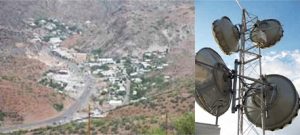
A dual-band, two-way microwave system was recently installed by MSO Cable One in Morenci, Arizona, providing an all-digital wireless HFC extension capable of delivering the same Digital TV and DOCSIS cable modem services offered in the nearby Safford, Arizona system.
The wireless HFC system was selected over the two other possible alternatives: a fiber link from the Safford headend or a stand-alone headend. The main reason is that it is much more cost effective, which is a significant consideration when providing service for areas with under one thousand subscribers.
The Morenci system had previously received off-air broadcast signals from Safford via a two-hop FM microwave system. The links are 23.3 and 11.7 miles long respectively, for a total of 35 line-of-sight miles.
Cable One decided to implement an all-digital service. The microwave system operates with multiple carriers, all with 256-QAM modulation. The initial 13 GHz downstream transmission rate is 814 Mbps, but the system has capacity to transmit upwards of 3 Gbps.
The 18 GHz upstream was designed to accommodate multiple 16-QAM signals from each of the four nodes. With the increasingly symmetrical nature of subscriber data traffic, more than one upstream channel was required. Cable AML developed a synchronized, block-conversion system to transport four independent upstream channels (each from 5 to 42 MHz) through the two-hop microwave system back to Safford for integration into the CATV return network.
The upstream service in the 18GHz band required the installation of new antennas and waveguide jumpers at the transmitter site at Morenci, the repeater at Guthrie Peak and the receiver at Safford.

Servicio de Telecable de Huejutla , a Cable Operator in Huejutla (Mexico), needed to get Cable TV signals to the towns of Tehuetlan, Ataplexco and Huautla, at distances from the headend in Huejutla ranging from 14 Km to 30 Km.
The company chose a Cable AML microwave system consisting of a transmitter at the Headend in Huejutla, a repeater at San Francisco and receivers at each of the 3 towns.
Rugged terrain between the towns posed an enormous challenge. The trip up the mountain at San Francisco was so treacherous that vehicles and pack animals were not an option. All the equipment was all carried by people on foot, then assembled onsite by company engineers.
Fiber was an unlikely option due to the terrain, but if it had been possible to run cables between the various sites, it would have cost as much as five times more. Instead, the company was able to deliver Cable TV service to the three towns efficiently and at a much lower cost.
While Servicio Telecable Huejutla has no immediate plans to provide Internet service, the Cable AML system can be upgraded in the future to two-way service. Mmds digital system upgraded in Lithuania’s capital city.

US Cable Operator Time Warner has recently installed an 18 GHz digital microwave system to transport 256-QAM modulated carriers from the Hawaiian island of Maui to three separate receiving points.
The company chose a Cable AML microwave system consisting of a transmitter at the Headend in Huejutla, a repeater at San Francisco and receivers at each of the 3 towns.The islands of Molokai and Lanai and the isolated town of Hanna in Hawaii receive Cable TV signals (54 to 600MHz) from the main Headend in Maui via 13GHz broadband microwave links from Cable AML. Time Warner wanted to expand this carriage to include the 256-QAM digital video services (with carriers above 600MHz on the Maui cable system), but regulatory bandwidth limitations in the 13 GHz band made it necessary to use the18 GHz band for the digital carriers.The 15 mile link to Lanai and the 13 mile link to Molokai, both over water, were straightforward for the 256-QAM digital video.
The link to Hanna was more demanding due to two factors: a longer distance and the existing double passive reflector (billboards) in the path. The reflectors were designed for 13 GHz and had unknown performance characteristics at 18GHz.An additional requirement was that the link had to work using existing 13 GHz antennas at the transmitter site in Maui due to size restrictions imposed by National Park authorities. This was accomplished by using specially designed dual-frequency feed horns sharing the same antenna aperture.
Howard Feig was the Time Warner Engineer who designed, installed and commissioned the microwave hardware manufactured by Cable AML for this link. According to Howard, “Cable AML once again has provided an excellent solution for a very demanding link, continuing a tradition of good quality equipment and service lasting for over 15 years.”
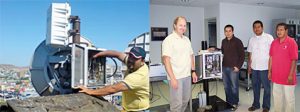
Grupo Caliente, a leading video distribution company in Tijuana, Mexico, has recently upgraded a microwave point-to-point distribution system with hardware manufactured by Cable AML.
The system was designed for local distribution of 25 TV programs from the originating point at Pueblo Amigo to three receiving points and to a relay (repeater) station located at Hipodromo, from where it is further distributed to four additional receiving points.
Grupo’s Microwave Engineering group lead by Eng. Jose Manuel Sanchez performed the installation and commissioning of the links. According to Eng. Sanchez, “The new Cable AML microwave equipment has resulted in a very high quality multichannel video signal with excellent reliability at all of our terminal distribution centers. We are very pleased with Cable AML’s microwave equipment and we look forward to continuing to expand our system to additional hubs.”
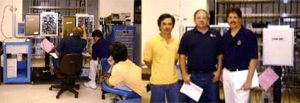
Another state-of-the-art, two-way AML system has been delivered to ATT-COMCAST for installation in an HFC cable system in California.
The system is designed to provide two-way cable modem service to communities served by microwave.
With the new system, it is possible to increase the downstream digital channel carriage capacity of an existing AML link by expanding the downstream into the 550 to 750 MHz range and the upstream band in the 5 to 42 MHz range.
This makes it possible to simultaneously increase channel capacity and provide two-way DOCSIS cable modem service to three different receiver sites from a central hub.
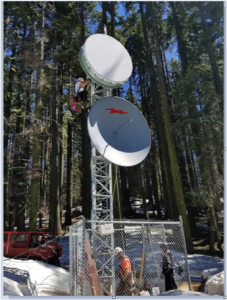
A leading US Cable and Internet Operator has recently upgraded an existing microwave link by installing a new bi-directional 18 GHz system to provide increased downstream channel capacity and upstream DOCSIS capability.
The state-of-the-art Cable AML microwave system consists of a broadband transceiver at the Headend, a Repeater at 18 miles ( 29Km) and a second transceiver at 14 miles (22 Km) from the repeater site.
The complete bi-directional system can transport a total of 100 256QAM carriers downstream and DOCSIS upstream carriers. Cable AML designs and manufactures broadband microwave systems for transmission of multichannel digital Cable TV signals to locations difficult to access or too far to be accessed by fiber or coaxial cable.
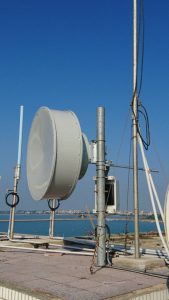
CINET in Taiwan has recently completed the installation and commissioning of a point to point microwave link to transport the analog and digital cable TV signals from the mainland to an Island 3 Km distant. The microwave system consists of a broadband outdoor transmitter operating in the 12.7 to 13.25 GHz band, and an outdoor broadband receiver.
At the transmitter site, the cable signal is fed directly to the transmitter in the frequency range of 54 to 600 MHz. At the receiver site, the microwave receiver connects directly to the local cable network without the need for frequency converters or any other equipment. The microwave system provides Cable TV service to the cable subscriber in the Island without the need to install a new headend.
Miranda Chen, CINET Vice President, says “we are very pleased with the quality of the signal and the level of support from Cable AML during installation and commissioning of the system.”

A leading US Cable Operator has recently completed the upgrade of a microwave system transporting HFC Cable TV signals from the Headend to four hubs 17 miles (27 Km) away.
The microwave system consists of a high-power broadband transmitter operating in the 12.7 to 13.2 GHz band. The output of the transmitter feeds four paths simultaneously. At each of the four receiver sites, the receiver output is directly connected to the local cable plant.
The Cable AML broadband high power transmitters can be used in the hub-and- spoke configuration to transport HFC (Cable TV) signals at a significantly lower cost than other alternatives.

A leading US Cable Operator has recently upgraded a Digital Microwave Backbone network designed to transport 256-QAM modulated carriers from the Cable TV Headend to eight local cable systems.
The company upgraded an old FM backbone with a state-of-the-art Cable AML microwave system consisting of a broadband transmitter at the headend, and a repeater at 18.3 miles – feeding two additional transmitters for final relay to 8 different cable systems located in eight different localities.The digital backbone covers a total distance of 61.3 miles from the Headend to the most distant receiver.
With the backbone in place, the Cable Operator is now providing a large number of digital programs to a significant number of customers spread over a large area. Cable AML designs and manufactures broadband microwave systems for transmission of multichannel digital Cable TV signals to locations difficult to access or too far to be accessed by fiber or coaxial cable.

CINET, a systems integration company based in Taiwan, has recently finished training at Cable AML’s facilities in California for their new broadband Microwave Link – designed to transport up to 75 digital DOCSIS and Video QAM’s.
The system consists of a Broadband Outdoor Transmitter operating in the 13 GHz band, feeding one pathover the ocean to reach an island, where a receiver feeds he local cable network directly. The microwave link will make it possible to provide cable TV service to the island without the need to install a new Headend.
According to Miranda Chen, Vice President of CINET, “I am very pleased with the quality of the signal and the level of support Cable AML provided for my team during our visit. We look forward to provide our customers with this exciting technology for expansion of their networks to previously unreachable places”.
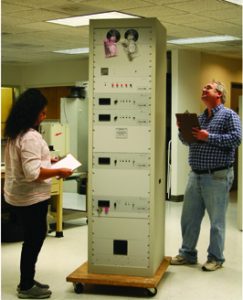
Significant cost savings and performance improvement have been achieved by a US Cable Company by replacing an older channelized AML transmitter with a new broadband high power unit from Cable AML.
The ITX-1300 transmitter transports a mix of analog and digital channels, including QAM256 streams over two links of 42 and 58 Km, the second of which feeds a repeater that extends the link for another 28 Km.
According to the Company’s Technical Operations Manager, “the transmitter is providing excellent performance after several months, requires practically no maintenance and no service calls.”

CCC (Compañia de Circuitos Cerrados), the cable company providing service to the city of San Miguel de Tucuman (Argentina) and its surrounding area, has just installed a new extension of the existing microwave network that has been in service continuously since 1994.
The new 12 Km link was launched with a broadband transmitter ITX-011 multiplexed with the existing transmitters to provide built-in redundancy. With the implementation of this link it has been possible to expand the cable system at a lower cost than would be possible with fiber.
Eng. Juan Ise, Technical Manager of CCC, said that “given the reliability of Cable AML’s equipment, as demonstrated for over 15 years of continuous operation here in Tucuman, it has been a really easy decision to expand the system with microwaves.”
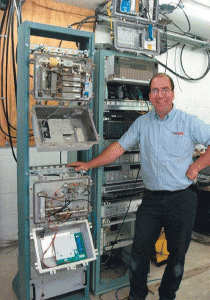
Cable AML has concluded an upgrade of an existing bi-directional AML system linking the towns of Natchez (Mississippi) and Vidalia (Louisiana) across the Mississippi River.
Cable operator Cable One wanted to improve the reliability of the link to provide better upstream DOCSIS modem service to Vidalia subscribers from the existing Headend at Natchez.
The improvements required eliminating a tower-mounted LNA which was prone to failures due to the high frequency of lightning strikes on the tower. To compensate the losses through a long run of elliptical waveguide, a high power upstream transmitter was installed and integrated with the existing broadband downlink used for analog and digital video transmission.
An extra benefit of the upgrade was to improve clear-weather carrier-to-noise and also fade margin.

Cable AML has implemented a full digital upstream upgrade to an existing 54 to 550 MHz downstream AML System. The upgrade allows full bi-directional cable service in areas that are expected to generate significant income growth, because marketing studies showed that DOCSIS Modem service and Set Top Box interactivity were important issues for increasing revenue.
The existing downstream system consisted of a transmitter at Sedona ( Arizona) delivering signals to five remote sites via a repeater array at Mingus Mountain. Cable AML designed the upgrade and assisted in the installation and turn-on.
Upstream capability was implemented without the need to change or add to the existing antennas. Local and remote transceivers were implemented by using existing receivers, originally purchased form another company, thus saving NPG tens of thousands of dollars.
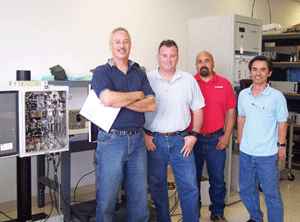
The 16 mile AML link to the isolated mountain community of Idyllwild has been providing reliable signal delivery for years, but until August of this year it was a one way link limited to 54 MHz – 550MHz transmission. Fiber was not a viable alternative due both to cost and exposure to forest fire damage.
A pair of Cable AML transceivers was added to the existing link, expanding DownStream carriage to 54 – 860 MHz and Upstream 5 – 42 MHz… a full wireless HFC extension, installed with virtually no interruption to the 54 – 550 MHz service.
Now subscribers in Idyllwild have the same HSD and digital video services that other Adelphia subscribers enjoy.
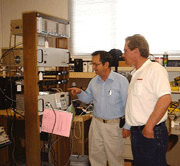
Cable AML has delivered a Wireless HFC Extension to provide 54 to 870 MHz downstream service plus 5 to 42 MHz return for Cable Modems and Interactive Set-top boxes (STBs) between the master headend and a subscriber pocket at a distance of 14 miles (22.4 Kms).
Cable operators are selecting two-way AML microwave links for two-way plant upgrades because in many situations microwave has significantly lower cost than fiber. For example, the system recently delivered by Cable AML has a LOS (line of sight) distance of 14 miles, which is equivalent on the average to twenty miles (32 Kms) of fiber. Depending on terrain and other factors, fiber can cost more than twice the cost of the two-way AML link.

Cable AML has delivered an AML Cable Modem Return system to serve a single remote service area. The AML return system is a cost-effective method of providing cable modem service to small pockets of subscribers already served by microwave.
The AML return system was implemented in an existing link providing the full 54 to 550 MHz downstream and it covers the complete 5 to 42 MHz bandwidth used by DOCSIS modems in the upstream. The system design allows for future expansion of the downstream carriage from 550 to 870 MHz.

A point-to-point AML link which 80-channel capacity has been installed by Telecomunicaciones de China in the city of China (Tamaulipas, Mexico) to transport Cable TV signals from the local headend to the city of General Bravo, over a distance of 8 miles.
The system was installed and commissioned by Eng. Alma Alarcón and Ing. Jesús Chacón following the training course at Cable AML’s facilities in Torrance, California.
The transmit antenna was mounted on a T45 tower at a height of 27 meters and the receiver antenna at a height of 40 meters. Because of the high winds prevalent over the area, radomes were installed on the antennas to minimize wind damage.
According to Eng. Alarcón, “the AML link is allowing us to offer Cable TV service in General Bravo with excellent signal quality and at a much lower cost than any of the alternatives available.”
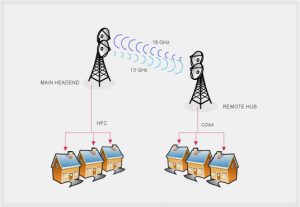
Cable operators utilizing wireless links to reach subscriber pockets too difficult or too expensive to serve via HFC will be pleased to learn of Cable AML’s new line of wireless extension products. These products enable operators to:
(1) Provide a wireless return path for the latest bi-directional services such as high-speed internet access, video-conferencing, Voice-over-IP, etc. (2) Add downstream capacity for more video as well as data; and (3) Achieve these goals cost-effectively, without sacrificing existing bandwidth.
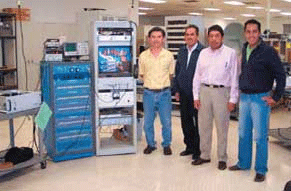
Mexican Cable Operator Sistema de Comunicaciones de Quiroga has started to provide cable service to the towns of San Andres and Eronguaricaro in the state of Michoacan (Mexico) from an existing headend at Quiroga.
Two AML links fed from the same transmitter were used to transport the 65 channels from the headend to the two towns at distances of 11 Kms and 25 Kms respectively. The second of the paths is mostly over water, crossing Lake Eronguaricaro.
Following a site evaluation survey, a transmitter site was selected near the Quiroga headend, from which there was good line of sight to the two towns. The headend signal was transported to this site by a 2.5-mile (4 Kilometer) fiber link. Following the installation and commissioning of the two links, the cable operator is now providing 65-channel cable service in both towns.
According to Alejandro Baltazar, General Manager of the company, “we are extremely pleased with the performance of the system. We did all the installation ourselves with some guidance from Cable AML and we have been able to start providing cable service to an area where it as imperative to offer service quickly and at low cost. Due to the relatively short straight-line distance over Lake Eronguaricaro, the only other alternative was to install a long and costly fiber link or to purchase, install and operate two additional headends. We strongly recommend the Cable AML solution to any cable operator in Mexico that needs to transport the cable signals efficiently and easily.”
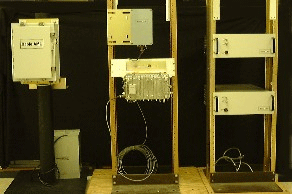
Cable AML has manufactured and delivered a broadband AML system with a contiguous channel input and output covering the full 54 to 750 MHz band. The system provides seamless transmission of the whole band without loss of channels because it does not rely on guard-bands for crossover.Cable Operators can now use an AML trunking solution for advanced broadband cable plants. The able AML solution multiplexes the input VHF signals into the two available CARS (Community Antenna Relay System) Bands, one centered at 13 GHz and one centered at 18 GHz, to provide 700 MHz total bandwidth capability. Like all P-T-P (Point to Point) systems from Cable AML, the system accepts analog (AM or FM), digital (QAM) or any mixture of both types of channels.

US Cable Operator Cable One has upgraded a 23-mile FM link in Clarksdale, originally used to transport seven distant TV stations, to now transport SDTV and HDTV digital signals with 8VSB modulation.
Two AML links fed from the same transmitter were used to transport the 65 channels from the headend to the two towns at distances of 11 Kms and 25 Kms respectively. The second of the paths is mostly over water, crossing Lake Eronguaricaro.
The traditional way to transport HDTV signals, which was to demodulate them to ASI Transport Streams and then to transmit each one through a digital radio, is very expensive for a multi-carrier application. The method implemented by Cable AML is the least complex, least expensive and most reliable approach. The 8-VSB modulated, 6 MHz-wide digital signals were frequency-multiplexed and transported through a broadband Cable AML transmitter.
At the receive site the AML receiver delivers all the carriers on a single cable, which is linked to the headend. The 8VSB signals can be demodulated to ASI and/or baseband audio and video, depending on how they are to be used.
The antennas and waveguide previously used for the FM microwave were suitable for the broadband AML transport of the 8VSB signals. Using the same antennas and waveguide, allowed an electronics only upgrade to a digital link, minimizing the cost and installation time.

A broadband, high-power AML transmitter has been delivered to a cable system to replace an older, channelized unit that provided service for many years to an isolated island community in the US.
The new transmitter will make it possible to provide any mix of analog and digital channels, thus allowing additional channels and digital service upgrades without hardware changes. It operates over a 13 mile (21 Kilometer) link feeding a broadband active repeater. The combined transmitter-repeater link spans a distance of over 20 miles (32 Kilometers).
The ITX-1300S is Cable AML’s highest power transmitter operating in the 12.7 to 13.2 GHz CARS (Community Antenna Relay Service) band. It replaces a large room full of Hughes channelized STX-141 transmitters, each of which was designed to transmit only one analog VSBAM channel. The ITX-1300S incorporates solid state GaAs FET power amplifiers with built-in redundancy and a state-of-the-art dual feed-forward control loop. It is designed to power high-reliability links operating at full capacity over difficult propagation environments.
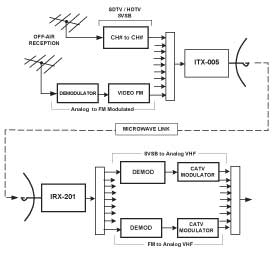
US Cable operator ADELPHIA has upgraded an existing Cable AML link to provide for transport of high-quality 8VSB-modulated off-air TV signals from a remote location to the central headend.
The link was originally installed several years ago to transport a number of distant off-air channels into Susanville (California). The Cable AML equipment replaced old channelized FM video radios that had developed serious reliability issues.
When the digital 8VSB off-air signals became available, Cable AML analyzed the possibility of transporting the digital carriers through the existing AML radios and concluded that it could be done by just upgrading the IF output of the receiver.
The digital 8VSB carriers were then added to the existing link together with the FM video channels. According to Mike Miller of Adelphia, “with the combined analog and digital signals, the AML link has been performing superbly.”.

The cost of providing cable service to to a small California community within a franchise area was minimized thanks to a well designed AML system. The Cable AML model ITX-011 broadband transmitter is the cornerstone of this system.
The 13 GHz transmitter has the capability of providing high-quality analog or digital TV signals in a 17 mile (28 Kilometer) link.
With a one-way capacity of 80 analog channels, the link is designed to be easily upgraded for two-way service if, and when, cable modems are installed in the service area. Moreover, the ITX-011 system architecture enables the operator to upgrade the transmitter to a higher power configuration if required.
A veritable workhorse in service at many cable systems, the ITX-011 includes an “F” connector port and a toggle switch at the front panel to facilitate diagnostics by allowing rapid comparison of the transmitter input and output signals at VHF.
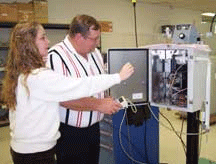
AML links continue to be used by many Cable TV operators to transport off-air TV signals from nearby cities to the cable system Headend.
Cable One wanted to transport TV off-airs from the Houston TV stations to the cable system in Fort Lavaca (Texas), about 140 miles away. Due to the large distance between the two sites and the difficult propagation environment in the area, the reliability of the direct pick up signals was poor, which is why Cable One had been using a 6 GHz FM Common Carrier Link with 3-channel capacity to transport analog signals from an intermediate point between the two locations.
When the need arose to transport the new HDTV channels and to add additional analog channels, the 6 GHz link was no longer a feasible solution. Cable AML has provided an enhanced 13 GHz digital AML link that transports the added channel load as well as the HDTV channels.
Martin Schooley, Technical Operations Manager of Cable One, said he is very much looking forward to this upgrade of the old analog link, “It is something I have fought over for a long time,” he said.
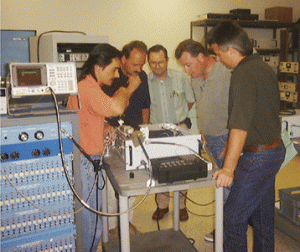
Cable AML continues to deliver broadband AML transmitters to replace older channelized units. Operational savings in power consumption and reduced repair and maintenance costs provide ample financial justification for replacing aging channelized units that serve fewer paths than when originally installed.
Operators often mention the carriage of the new HITS digital signals and/or the carriage of the data carriers to support DOCSIS and interactive set-tops boxes as additional reasons for upgrades to broadband microwave. Contact Cable AML application engineering for details.
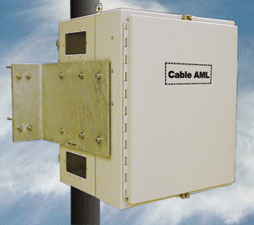
Cable AML has shipped the first of its new product range of High Power Outdoor transmitters and repeaters. The transmitter has been installed in Truckee, California, to replace an indoor unit.
Both the ITX-011 and ITX-050 models are now offered in outdoor versions. The OTX-011 has the equivalent output power of a 25W amplifier, several times more powerful than any previous outdoor transmitter. The OTX-050 has the equivalent output power of a 50W amplifier.
With the new transmitter, waveguide attenuation is reduced and the cost of air-conditioning requireis avoided.
Cable AML has been delivering high power outdoor transmitters and transceivers operating in the 23, 26 and 28 GHz bands for over five years. At these millimeter wave frequencies even a 10’ (3m) waveguide causes unacceptable attenuation, so outdoor high power devices are mandatory. The outdoor technology has now been made available for 13 GHz transmitters.
Cable MSO’s continue to upgrade microwave distribution systems originally installed in the 80′s with modern, broadband AML transmitters that offer substantial operational advantages and savings. The latest example is Cable AML’s ITX-1260D Dual Redundant Transmitter, the most powerful broadband transmitter in the world, which has replaced an STX-141 klystron-based system consisting of sixteen bays, each8 feet (2.4 meters) high.
The new system has yielded better signal quality throughout the cable plant. Additional benefits from the upgrade are the extra space available at the headend (which was used to accommodate new cable modem and VOD equipment, reduced power consumption (from 280,000 KWhr/year to less than 20,000 KWhr/year), reduced A/C (Air Conditioning) maintenance and operating costs and significantly improved headend noise environment.
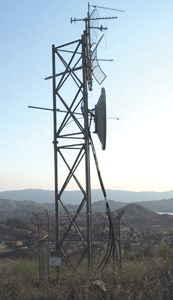
Mediacom recently installed a Cable AML digital link to dramatically improve the off-air signals in Sun City California. The links uses Cable AML’s Digital Headend Module.
Local-into-local DBS carriage of off-airs represents a serious competitive problem when the CATV operator suffers from less than perfect off-air pickup.
By using digital technology for transport, Cable AML provides a significant improvement in picture quality as well as an reduction in required microwave spectrum or an increase in signal carriage capability. Each Cable AML Digital Headend Module can digitize as many as six video programs into a single 6MHz channel for high quality transport over new or existing microwave links.

Space combining can be an effective technique for selectively adding channels and/or increasing power on a specific point-to-point path. The technique was adopted to feed one of several AML receive sites with a different channel line-up than the others.
The additional channels required at the site were fed to a separate broadband transmitter and connected to a separate antenna which illuminates the particular receive site. The channels are received in their respective frequencies by the standard AML broadband receiver, combining in space with the channels already being sent to this and all the other AML sites.
Cable AML’s model ITX-100 power-doubling transmitter was used for this application due to the high power required and the built-in redundancy of this type of transmitter.
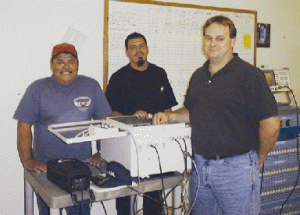
Adelphia’s Cable System in Yuma, Arizona, has been providing the Yuma Proving Grounds with Cable TV service for several years with a 54 – 550MHz link from Cable AML. This 16-mile (26 Km) link was recently upgraded to a full wireless HFC extension, using a pair of TRX18-002 transceivers operating in the 18 GHz frequency band.
Dual Redundant 8 GHz Receivers for Digital AML Link The upgraded system expands the downstream path to 550 – 750 MHz and provides a 5 – 42 MHz upstream path for cable modem return signals.
The wireless HFC extension crosses the Colorado River at one of its widest points. “The Cable AML dual-frequency link has been performing perfectly,” said Hugh Williams.

IRX-111 Indoor Broadband Receiver used in FM multi-channel transmission Cable AML has supplied a very cost-effective broadband FM link for transport of multi-channel TV broadcast signals in a multi-hop configuration involving fiber and microwave. The link involves transporting, via fiber, several CARS-band (13 GHz) FM single-channel signals from a receive location at a distant point to a Cable AML 18 GHz broadband transmitter for transmission to a 21 Km link over water.
Single-channel multi-hop FM video links have been in operation for many years. As operators need to add channels or to transport digital signals, stacking single-channel radios becomes more costly and less effective.
The Cable AML approach bundles the signals to eliminate the need for channel-by-channel demodulation/modulation of the multi-channel signal at each hop, whether fiber or microwave, thereby reducing system complexity and cost.

A Cable AML wireless network carrying digitized television and Internet backbone data now provides several smaller California communities with the same level of service available in larger communities served by metropolitan fiber.
The system transports fourteen NTSC television off-air channels and 100Base T data. The signals are MPEG-2 encoded, multiplexed, and modulated using Cable AML’s DHM-4001 digital headend mod-ules. The QPSK-modulated video is multiplexed with the Ethernet data and transported 26 miles (42 km) to a bidirectional repeater site and then on to two communities, one 35 miles (56 km) away and the other 16 miles (25 km) away.
By adding Internet backbone capacity to a digitized video backbone transport link, Adelphia can offer much higher data rates to its DOCSIS cable customers at a low incremental capital cost and without paying monthly transport fees to the common carrier.

Neville Greene checking power levels during hands-on training session Several years ago, Cable AML developed 8 GHz AML systems in order to provide reliable signal transportation in adverse rainfall environments.
We have just delivered another 8 GHz AML system for this purpose. The system was designed to replace an 18 GHz link which had been suffering excessive loss of signal during the intense rain periods common to the area.
A broadband transmitter and receiver pair, complete with Pilot Tone for frequency locking and receiver VHF AGC were delivered and successfully installed.
The system, operating in the 7861.905 to 8358.905 MHz band, is now in use with a channel loading of 40 analog video channels.

Cable AML refurbished equipment for a cost-effective way to feed remote subscriber pockets and to improve signal quality of off-air TV signals.
For example, the customer-owned equipment shown in the photograph was re-deployed by a major system operator to serve a smaller CATV system which is 25 miles from the nearest major market. The system had been suffering from poor off-air signals and high T-1 costs for their Cable Modem service.
Cable AML can bring you higher-quality signals and can expand your service area using cost-effective solutions with refurbished and recertified broadband AML equipment.

Cable AML radios can provide significant cost savings when used to transport HITS (Headend in the Sky) signals from one headend to neighboring headends.
The HITS system delivers QPSK digital signals to cable headends via satellite. Each carriers is modulated with five to eight digitally compressed video programs at 27 Mbps. At each headend the HITS signals are downconverted and their modulation is changed from QPSK to 64-QAM so that each carrier fits within the standard 6 MHz channel bandwidth. From one to fifteen digitally modulated 64-QAM carriers can be carried in the cable plant.
Four ATX-033 transmitters racked to provide digital signal to 4 separate headends Cable AML’s broadband system can be used to transport the 64-QAM carriers from a master headend to nearby headends, thus avoiding the expense of duplicating the HITS satellite receiver and trans-modulation equipment.
Tests of standard production Cable AML’s broadband transmitters and receivers were made at the National Digital Television Center by R&A Management, GI, TCI, and Cable AML to characterize the performance of the equipment when used in the digital-only transport mode.
Cable AML’s links are also used by Cable TV Operators to transport a combination of analog and digital signals. For example, a typical combination might include 56 VSB-AM analog video channels, 15 digital video carriers (64-QAM), and several QPSK data carriers. The data carriers are for EPG (Electronic Program Guide) information, conditional access, control data, and DMX (Digital Audio Signal).

18 GHz two-way system elements with upstream components, down-stream components and outdoor downconverter of the SRX18-201 receiversCable AML has delivered a two-way, 18 GHz system designed to transmit a combination of analog and digital signals both downstream and upstream.
The downstream load consists of a total of twenty five TV channels (thirteen NTSC channels and ten PAL B channels), plus two E1 digital data channels. The upstream load includes twelve PAL B TV channels and data channels.
The system incorporates an ITX18-005 transmitter and an SRX18-201 phase-locked receiver at the headend site and a second ITX18-005 transmitter and an SRX18-201 Composite AGC receiver at the remote hub located 5 Km away.
The SRX series receivers are two-piece receivers, with an outdoor downconverter mounted directly on the antenna to minimize waveguide loss; and an indoor VHF Processor unit that connects to the Downconverter with standard cables.
As with all Cable AML broadband products, the transmitters and receivers are digital-ready. This is but one more in a long list of examples of Cable AML’s world class wireless system design and implementation capability. Cable AML has routinely solved hundreds of wireless application challenges of every type.

Two-Way Multi-Carrier STL (Studio-To-Transmitter Link) Cable AML has installed a high-capacity, two-way, multi-carrier STL (Studio to Transmitter Link) operating in the millimeter-wave bands of 27.5 – 28.0 GHz (downstream) and 31.0 – 31.3 GHz (upstream). The link is designed to interconnect an LMDS headend with a remote Base Station featuring Cable AML’s wideband, high-power transceivers.
Cable AML’s broadband multi-carrier system design makes it possible to interconnect several base stations to a single LMDS headend where all the digital modulation and demodulation equipment is housed, reducing system cost and complexity.
Conventional system designs based on single-carrier radios are implemented with one full duplex link per carrier and require digital re-modulation at each base station. Cable AML multi-carrier approach drastically reduces the cost and complexity of the interface equipment between the STL and the LMDS transceivers at each base station.
The third Canadian installation of Cable AML’s new ITX-100 high-power transmitter was completed in March by Cable AML distributor Capella Telecommunications.
The ITX-100 transmitter is part of a microwave distribution network which also utilizes a very high power ITX-500 transmitter and an IAR-011 repeater. Cable AML’s ORX-201 phase-lock, low-noise receivers are used for large distribution areas, and refurbished receivers are used to serve areas with as few as 100 subscribers.
The ITX-100 is ideal for digital (or analog plus digital) transmission due to its unique architecture that offers fail-soft performance in the event of the failure of a power amplifier or its power supply. The fail-soft architecture avoids the disruption to the digital signals that may occur when transmitters are switched into redundancy
A total of 13 headends were replaced by this Cable AML system. The AML network now delivering 60 analog television channels was designed with a 78 channel capability to accommodate a projected growth in the near feature.
Developed by The Dhwalin